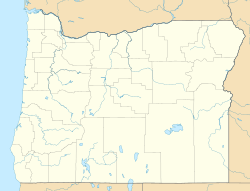Auburn, Oregon facts for kids
Quick facts for kids
Auburn, Oregon
|
|
|---|---|
|
Former unincorporated community
|
|
| Country | United States |
| State | Oregon |
| County | Baker |
| Elevation | 4,213 ft (1,284 m) |
| Time zone | UTC-8 (Pacific (PST)) |
| • Summer (DST) | UTC-7 (PDT) |
| Area codes | 458 and 541 |
| GNIS feature ID | 1136017 |
Auburn was once a busy community in Baker County, Oregon. Today, it is known as a ghost town. It is located off Oregon Route 7, southwest of Baker City. You can find it near the Blue Mountains.
Contents
The Rise and Fall of Auburn
Auburn was not always a bustling place. For a long time, it had only one or two buildings. But everything changed in 1861. That year, people discovered gold nearby! This discovery quickly turned Auburn into a lively boomtown.
Gold Rush Excitement
The news of gold brought many people to Auburn. By September 1862, the small settlement had grown into a real town. It boasted over 20 stores and about 1,000 homes. These businesses and homes supported the many miners working in the area.
At its peak, Auburn was the largest community in all of Eastern Oregon. It was a very important place for the region.
A County Seat's Short Reign
Because Auburn was growing so fast, the Oregon Legislative Assembly made it the first county seat for Baker County. This meant Auburn was the main center for government and official business in the county.
However, Auburn's boom did not last forever. By the 1870s, the gold began to run out. Many people moved away to find new opportunities. By 1873, Auburn's population had dropped to only 200 people.
The Post Office Closes
The town's post office was very important. It was the first one in northeast Oregon. It opened on November 1, 1862, with William F. McCrary as its first postmaster. But as the town emptied, the post office eventually closed in 1903. This was a sign that Auburn was no longer a busy place.
Today, Auburn is mostly deserted. It stands as a reminder of Oregon's exciting gold rush history.



